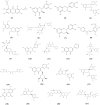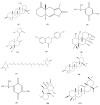Mechanism of drug-induced liver injury and hepatoprotective effects of natural drugs
- PMID: 34895294
- PMCID: PMC8665608
- DOI: 10.1186/s13020-021-00543-x
Mechanism of drug-induced liver injury and hepatoprotective effects of natural drugs
Abstract
Drug-induced liver injury (DILI) is a common adverse drug reaction (ADR) and a serious threat to health that affects disease treatments. At present, no targeted clinical drugs are available for DILI. Traditional natural medicines have been widely used as health products. Some natural medicines exert specific hepatoprotective effects, with few side effects and significant clinical efficacy. Thus, natural medicines may be a promising direction for DILI treatment. In this review, we summarize the current knowledge, common drugs and mechanisms of DILI, as well as the clinical trials of natural drugs and their bioactive components in anticipation of the future development of potential hepatoprotective drugs.
Keywords: Bioactive components; Drug-induced liver injury; Mechanism; Natural medicines.
© 2021. The Author(s).
Conflict of interest statement
The authors declare that they have no conflict of interest.
Figures









References
Publication types
Grants and funding
LinkOut - more resources
Full Text Sources
Research Materials

